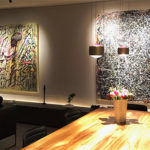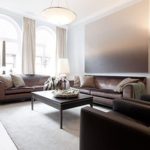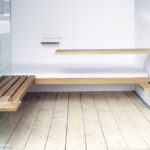
Visiting fachwerkraum: a new form of furniture!
With his idea “fachwerkraum furnitecture” Dominik Peitsch has developed a way to furnish small rooms efficiently. His furnishing has two main components: Profiles made of stainless steel (Two mounting options) and oak panels, which are attached to each other on the wall and thus can represent any type of furniture. The floor remains free and the height of attachment of the wooden panels decides whether it will be a bed, desk, bench or shelf. It is practically offered a large construction kit, which can be used individually by the resident. You can be the architect of your own room furnishings, and easily install them yourself!
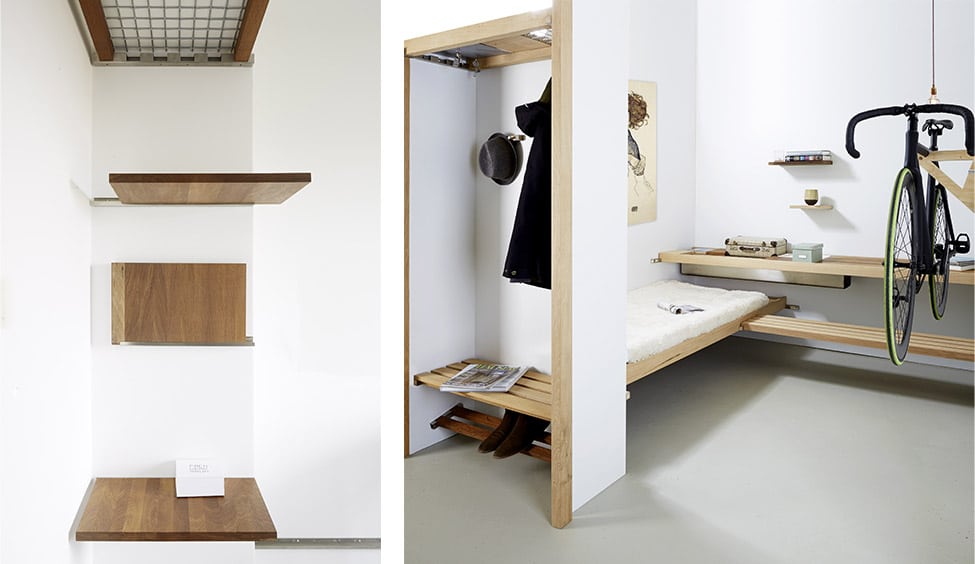
From the idea to the implementation- a long way
Hello Mr. Peitsch, thank you very much for the invitation to Bielefeld. After five years of planning, you have now founded your startup company in 2019. FACHWERKRAUM furnitecture deals with a new type of furniture. How did the idea come about? What inspired you?
A problem: I only had a room of 7 m² for my then 14-year-old son, where space had to be created for clothes and a bed in addition to a shelf, table and chair. That’s when I started fiddling around and initially tinkered with very elaborate components that would hardly have been affordable for customers. Then, using modern laser technology, it quickly became clear that a product could also be created for a market.
To what extent has your professional career helped you in product development and in founding a company?
Basically, it’s quite interesting: I started exporting for a company because I also learned many languages during my studies. As a graduate sociologist, you actually look for an economist for the position. But they didn’t have anyone who spoke two or three languages, so I took over. Before that, I learned wholesale and foreign trade in fashion. I then sold abroad, which nobody needed. Then I developed the marketing and founded the agency. I realized that the product itself needed to communicate. From then on, I took care of developers and advised the “crazy inventors”. That’s how I got into development, because I’ve always been involved in development. I also always wanted to work with wood. When I got in touch with Bethel, which also has a wood workshop, they made me my first wooden profiles. So basically it was all very organic.
On your website you write that the founding of the company is deliberately taking place in the Bauhaus year 2019. What is the relationship of your furniture to the Bauhaus movement?
I thought for a long time about when to turn the agency into the foundation of fachwerkraum. It was always clear that it was a Bauhaus product, and then when I saw that this year is the 100th anniversary, I thought, now you start in this year. Because it encompasses the two areas, architecture and furniture, where you see Bauhaus the most. The events for 100 years of Bauhaus really surprised me. I was also in Dessau last year and I think now a lot more people know that Bauhaus is not a hardware store. And those who know it say: these are the ugly houses from the 60s. The problem is, and it’s still the case with architects today, that they never consider what the property will look like in 100 years. But I actually come more from Art Nouveau. That was always more my thing.
What is the composition of your furniture?
It’s the most abstract furnishing system you can imagine. Because it has no design, it can be individualized and combined with everything, whether with functional aluminum boxes or with suitcases from the 50s. You can use it for 500 years and if something breaks, the janitor can replace it. The oak in particular is something that should last forever. The basic idea was minimalism and then there was the ambition that you can reuse the leftover pieces. So the ecological requirement is also very high. If you want to hold a champagne reception in your small hallway, you use the boards as small tables, otherwise they stand on end in the drawer profile and can thus be used as picture frames, for example. It was my ambition to reuse the principle of the same parts everywhere. So you have very simple basic elements: The tube, the wooden profile with 45 mm, the oak plate in 25 cm and then from this everything should arise. It all corresponds to the visual habits, the profiles and the wood everyone has already seen and one has the feeling as if it had always been there. This evokes familiarity.
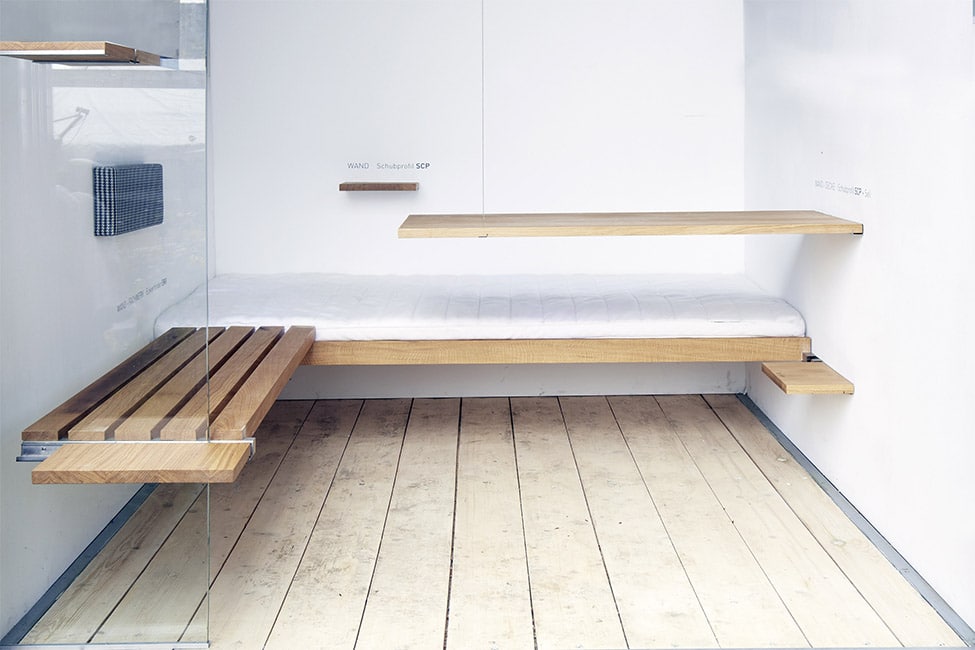
Do you find your interior design concept built into your home?
I had that built into the whole house, a single-family house, which I then sold. The new owner wanted to keep it, so I left it in. There was the crib with a length of 3m, where the children slept with their feet together. It offers itself just above all for small rooms or but to parcel.
Does your system do justice to people as individuals?
That’s a good question. I have the DIY concept, which is already much more identity. I can combine 1000 things with it, change it and above all fill it. There are basically only abstract specifications. I can also color the boards and use different colors on different sides of the boards. Then I can just flip the board over and have a different colored piece of furniture right away. I have the ability to make that out, I always say, because of “half-timbered space”. I’m someone who likes to remodel. I don’t know anyone who has changed their nursery that much. I can always take the profiles with me when I move and only have to buy the longest ones, because I can shorten the others. When I was traveling in Switzerland, I had 20 pieces of furniture in a Volvo V 50. Without mattress and slatted frame, but the basic construction and tools were all in one car.
Can people be happy in small spaces in the long run?
You have to think practically further. Just like sitting on a bicycle, you have the whole world as your environment; in a car, on the other hand, you only have one cubic meter to breathe. You always feel connected to the outside. That’s why there are so many entrance doors on the balcony at Bauhaus, for example. And outside, you have the whole universe around you. Because in the evening, you’re also happy when you come home in a little cocoon. You need both. If I have a room in Hyde Park in New York and I can furnish it with a half-timbered room, then I live more luxuriously than in the country with 500 square meters, because there I am connected to the whole world. You have to know what you want. And somewhere everyone strives for the combination of confinement and spaciousness, otherwise not so many would travel with the camper. And when I had my first apartment, where I had to decide every morning whether to go right or left, it was already too big for me. That was quite strange and then also alone. So you can be unhappy in rooms that are too big, as well as in rooms that are too small, and you can’t feel comfortable.
What excites you most about fachwerkraum?
The small set actually, what you can use so flexibly. Or the shoe rack. I can hang that on the wall at an angle so that the heel can behind it or straight. Or I can just hang a fruit crate in between. These very simple and small things are basically what’s interesting. And with the bed, you can show how even something classic can be better organized. There are many niches where I can say, I take a roof batten and order profiles and then I have used everything from the first to the last centimeter for a shoe rack. A carpenter once said the “democratization of carpentry.” It’s made-to-measure furniture, but at the same time it’s so standardized that any cabinetmaker can say: I’ll quickly build that for you. I once made 20 pieces of furniture in one day
What is your attitude towards minimalism?
There’s no other way. We have a duty to keep information out because of our constant connection to the world with phones and so on. Before I moved I didn’t buy anything for four years before and I always gave more away. Because then when I move I only want to have what I really care about. And that’s still a lot, so you would actually get by with much less. Where it used to be about survival with clothes and food, now it’s about ensuring survival by always remembering the essentials, because that frees you up. Everything else makes you sick. I think that’s the strategy for the future. There are just things, like my wooden locomotive, which I still have because it was on my birthday table when I was one year old. I would be deadly unhappy if I didn’t have it anymore. On the other hand, my car, I’d be happy if I didn’t have that anymore.
What were the special challenges in developing your vision?
Oh, the thousands of ideas. And the dimensions. So always thinking and waking up at night, does it work or doesn’t it work. What was it again, was this 20mm or 25mm? The math behind it, whether it works. But the biggest challenge is of course to find someone who enjoys it, who understands it, and who says we’re going to do something about it. I haven’t cracked that yet. I know I will never be successful with it, because I am much too small for that. I would have to live for 2000 years. The most beautiful success was when the editor-in-chief of the furniture market said to me: How long did it take you to do that? It’s so easy! And that was really nice. There were a lot of challenges and a lot of frustration, but also a lot of interesting encounters. The energy always comes back to you. Even if it’s not in the form of money, that’s quite amazing.
Where do you see your furnishing idea implemented and for whom is it particularly suitable?
In student residences, unfortunately, people don’t think in the long term. After a period of time, i.e. after about 10 years, everything is torn out again and something new comes in. So I said: My system costs twice as much, but you can use it for 500 years and then it’s only fiftieth as expensive. On the one hand, I’m minimal, but on the other hand, I’m surrounded by the most valuable materials there are, i.e. stainless steel and oak. And I don’t need the oak as a decor, but its material property is important. I don’t have any mechanics in here either, so what’s going to break? There are much greater tension forces used for centuries in half-timbered houses. And they are exposed to much more stress. So the reference objects would be honestly high-priced mobile homes and the big cities of this world. The real megacities. Where you know there’s no room.
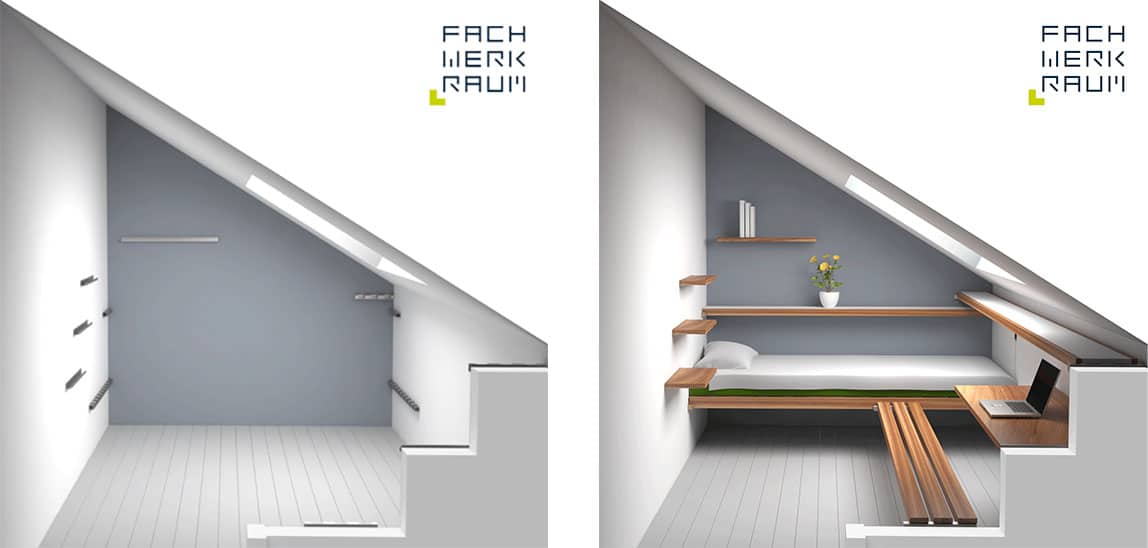
What do you hope for the future of your product?
The real highlight should be that there is a fachwerkraum app. There is now a photo function on the cell phone that assigns the bed, desk, wardrobe and shelf to the room. Then you get the parts list, the total price, and you can choose whether you want a craftsman to do it. For one room five pieces of furniture, that takes practically half a day. Then I make the appointments for delivery and if necessary the craftsman, and then I have the most efficient furnishings within a week. And at the same time it can be combined with everything. In three shifts, I would create a kilometer of rails.
Do you already have approaches to further develop the overall concept?
You can change both the profiles and the wood and then get a whole new feel and look. I would like to build a Lego room out of painted compact panels in the four basic colors. Then you have a real work of art on the wall. There are no limits. I have a sink, which has exactly the dimensions. But it’s no use spinning these things on forever and finally dying in beauty. Therefore, now the pragmatic approach.
What do you wish for the future development in the field of architecture and/or interior design?
Most of all, to consider what a surface will look like in the next decades. That goes completely under the radar. We had the current topic “Fridays for Future” in the 80s with the forest dieback, no one ever learned anything from that and I have the impression that it all fizzles out again just the same because no one sees their own responsibility either. I have not so much business interest, but that I do something good for the world. People don’t think far enough into the future, or they build too much too fast. And how great does it look when you’ve been in an old pub like this, where the oak benches look really used and you have the feeling that it has real character. Some wood is already being artificially aged because people want it that way and long for things to be durable. But everyone is talking about it. Everyone’s talking about tiny houses, minimalism, ecology and whatever else, and then you have a project like this and think to yourself that it fits in super well with the times, beats seven of the ten mega trends like urbanization, globalization, accessibility, DIY, etc., but I can’t get away with it.
Thank you for the interview and for the insights into your company. We wish you and the company FACHWERKRAUM furnitecture much success in the future!










